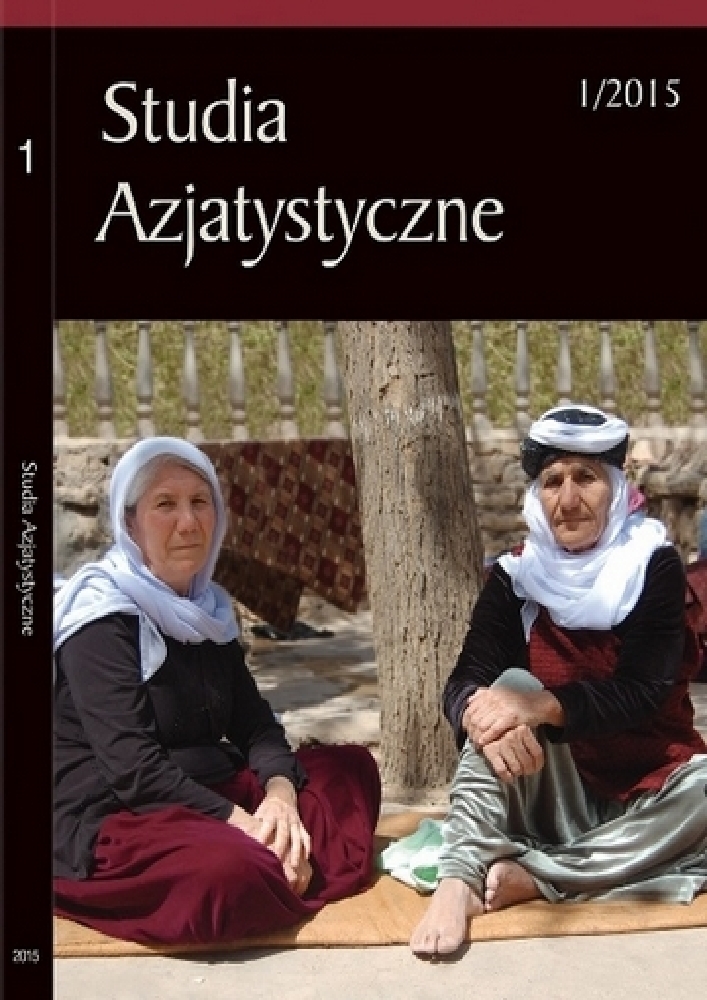Abstrakt
In the 8th century in Byzantine, Arabic and Chinese workshops weavers produced weft-faced compound twill silks (samits). These textiles were ornamented by confronted animals surrounded by pearls roundels. Usually, a rosette motive was placed between medallions. This design is a compilation of Sasanian (animals decorated with floating ribbons, pearl roundels) and Chinese patterns (symmetricalness, rosettes, ‘scrolled leaves’ motive). Its emergence took place in Central Asia. Some scholars think that it happened in Sogdiana, but the oldest samples of textiles made in the new tradition were found in Astana cemetery in Turfan Oasis (East Turkestan). Moreover, these textiles were warp-faced compound tabby – a weave technique characteristic of Chinese workshops. At first their composition was more Chinese than Sasanian, but successive Persian motives were more common. The most popular design was pearl roundels containing a confronted Pegasus standing on “a scrolled, pointed leaves in profile”. There is a large possibility that textiles found in Astana were produced locally in East Turkestan, probably in Turfan Oasis, which is located on the north branch of Silk Road. It was inhabited by a local community, but also by Sogdian and Chinese merchants. This cooperation could have led to syncretism in art and technical changes.
Bibliografia
Azarpay, Guitty (red.). 1981. Sogdian Painting: The Pictoral Epic in Oriental Art. Berkeley, Los Angeles, London: University of California Press.
Beal, Samuel. 1884. Si-Yu-Ki: Buddhist Record of the Western World. Translated from the Chinese of Xuanzang. Vol. II. London: Trübner & Co., Ludgate Hill.
Compareti, Mateo. 2006. The Role of the Sogdian Colonies in the Diffusion of the Pearl Roundels Pattern: Mateo Compareti, Paola Raffetta, Gianroberto Scarcia (red.). Ērān ud Anērān: Studies Presented to Boris Maršak on Occasion of His 70th Birthday. Venezia: Venezia Cafoscarina, 149-174.
Feltham, Heleanor. 2010. Lions, Silks and Silver: The Influence of Sasanian Persia, Sino-Platonic Papers 206, 1-51. Ghirshman, Roman. 1962. Iran, Parthians and Sasanians. London: Thames and Hudson.
Hansen, Valerie. 2005. The Impact of the Silk Road Trade on a Local Community: The Turfan Oasis, A.D. 500-800: Étienne De La Vaissière, Éric Trombert (red.). Les Sogdiens en Chine, Paris: Ecole Francaise Extreme Orient, 283-310.
Heller, Ammy. 1998. Some Preliminary Remarks on the Excavations at Dulan, Orientations 29, 84-95.
ageyama, Etsuko. 2006. Use and Production of Silks in Sogdiana: Mateo Compareti, Paola Raffetta, Gianroberto Scarcia (red.). Ērān ud Anērān: Studies Presented to Boris Maršak on Occasion of His 70th Birthday. Venezia: Venezia Cafoscarina, 317-332.
Liu, Xinru. 2010. The Silk Road in World History. Oxford: Oxford University Press.
Mallory, J.P., V.H. Mair. 2000. The Tarim Mummies. Ancient China and the Mystery of the Earliest Peoples from the West. London: Thames and Hudson.
Marshak, Boris I. 2006. The So-Called Zandanījī Silk: Comparison with the Art of Sogdia: Regula Schorta (red.). Central Asian Textiles and their Contexts in the Early Middle Ages. Riggisberg: AbeggStiftung, 49-60.
Sheng, Angela. 2006. Textiles from Astana: Art, Technology, and Social Change: Regula Schorta (red.). Central Asian Textiles and their Contexts in the Early Middle Ages. Riggisberg: Abegg-Stiftung, 117-127.
Sims-Williams, Nicholas. 1996. The Sogdian Merchants in China and India: Alfredo Cadonna, Lionello Lanciotti (red.). Cina e Iran da Alessandro Magno alla dinastia Tang, Orientalia Venetiana. Florence: Olschki, 45-67.
Stein, Aurel. 1907. Ancient Khotan: Detailed Report of Archaeological Explorations in Chinese Turkestan. Vol. I. Oxford: Clarendon Press. Watt, James C. Y., Anne E. Wardwell. 1997. When Silk Was Gold, Central Asian and Chinese Textiles. New York: Metropolitan Museum of Art.
Yokohari, Kazuko. 1991. An Essay on the Debut of the Chinese Samit Based on the Study of Astana Textiles, Bulletin of the Ancient Orient Museum Vol. XII, 41-101.
Yokohari, Kazuko. 2006. The Hōryū-ji Lion-hunting Silk and Related Silks: Regula Schorta (red.). Central Asian Textiles and their Contexts in the Early Middle Ages. Riggisberg: Abegg-Stiftung, 155-173.
Zhang Guang-da. 1996. The City States of the Tarim Basin: Boris A. Litvinsky (red.). History of Civilisations of Central Asia, vol. III: The Cross-roads of Civilizations: A.D. 250 to 750. Paris: UNESCO, 237-281.
Źródła internetowe
Pulleyblank, Edwin G. 1991. Chinese-Iranian Relations i. In Pre-Islamic Times: Encyclopædia Iranica [edycja on-line], http://www.iranicaonline.org/articles/chinese-iranian-i, dostęp: 27.07.2013.
Licencja

Ten utwór jest dostępny na licencji Creative Commons Uznanie autorstwa 4.0 Międzynarodowe.
